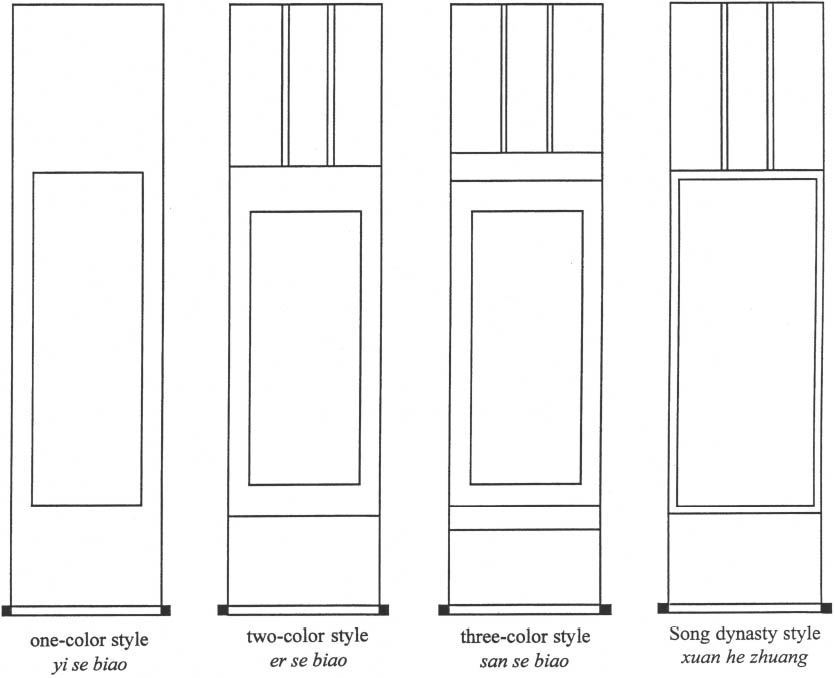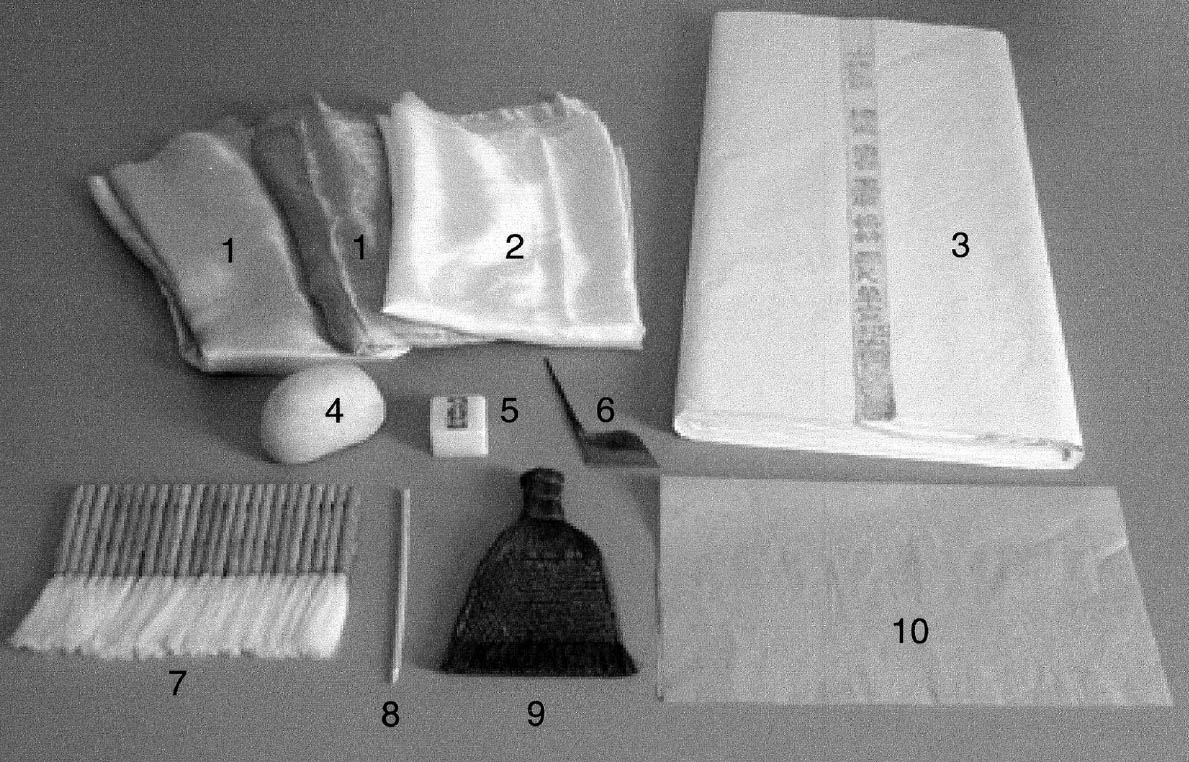THE TREATMENT OF CHINESE ANCESTOR PORTRAITS: AN INTRODUCTION TO CHINESE PAINTING CONSERVATION TECHNIQUES
VALERIE LEE, XIANGMEI GU, & YUAN-LI HOU
2 OBJECTIVES AND MATERIALS OF CHINESE PAINTING CONSERVATION
Chinese mounting and conservation techniques are
based on a traditional craft believed to have developed 2,000 years ago (Wills 1987). Aesthetic and structural objectives for hanging scrolls were already summarized in the Tang dynasty (618–907 A.D.) (Acker 1954) and remained almost unchanged up to the present date. Conservators may choose between four different hanging scroll styles for Chinese paintings: one-color (yi se biao), two-color (er se biao), three-color (san se biao), and the Song dynasty style (xuan he zhuang) (fig. 4). They are relatively free to make choices between mounting materials and style as long as the colors and design harmonize with the painting. The scroll should possess good flexibility in its ability to roll and unroll easily. One of the most important goals, and yet the most difficult to obtain, is that the scroll should hang perfectly flat. Conservators are particularly careful with the scroll details: cuts should be straight, corners should be square, joins should be of an even thickness, and mounting fabric patterns should be aligned at a 90� angle.
Hanging scrolls are very complex objects, as they are made with several types of materials (silk, paper, and wood), which all react differently to climatic changes. It is a real challenge to obtain a perfect hanging scroll, and the techniques used by conservators should be particularly precise so that scrolls can function properly. Because the painting and the scroll are structurally joined, defects in scrolls can ultimately
lead to damage to the work of art. The choice of paper and the paste consistency used for the multiple backings are key elements in the overall success of the mounting process. As an example, a stiff backing paper or differences in thickness between the painting and the mount may cause creases on the painting when it is rolled. While the scroll is considered replaceable in the Chinese tradition, every aspect of the conservation treatment involves both the painting and the scroll together. Consequently, Chinese painting conservation is a demanding task that requires a great deal of experience.
One interesting aspect of the East Asian painting conservation studio is that conservators of both Chinese and Japanese paintings work in the same space. This arrangement allows for a wonderful exchange of ideas and techniques, and, as you will read in this article, we used some Japanese papers and brushes when we thought they would provide better results. However, it should be emphasized that Japanese and Chinese mounting techniques are different in many regards, partially due to the nature of the materials used. For example, Chinese paper has shorter fibers than Japanese kozo paper and is difficult to handle when wet. However, its ability to attach to another Chinese paper is quite remarkable. As a result, very little paste is used for backing, giving great flexibility to scrolls. Our studio always uses the finest quality of xuan papers from the Anhui province (fig. 5), which is made from the bast fibers of pteroceltis tatarinowii maxim trees (also called blue sandalwood), mixed with rice straw (Tsai and Van der Reyden 1997). Papers come in different sizes (approximately 70 cm � 140 cm or 80 cm � 150 cm or 100 cm � 180 cm) and thicknesses (ranging from 0.25 mm to 0.8 mm). There are two different grades, depending on the percentages of blue sandalwood and rice straw used. They can be translated as pure or fine bark (jing pi) and cottonlike (mian liao). The mian liao papers are more flexible than the jing pi and are usually preferred for mounting scrolls. Xuan papers have an alkaline pH due to residual lime or wood ash used in the steaming
Fig. 4.
Four basic Chinese hanging scroll styles
 |
or cooking process of the pulp during the paper-making process (Tsai and Van der Reyden 1997). These papers have different textures on each side as a result of the drying process used in China: the newly formed sheets are placed against hot iron plates, a process that results in the side that was facing the plate being smooth and the side that was brushed against the plate being rough. The two sides can be easily distinguished because the rough side still has brush marks on its surface. Xuan papers can also be impregnated with paulownia oil to make them waterproof and more resistant to abrasion. They are then called shui you zhi. A sheet of shui you zhi can be placed temporarily between the backing papers and the smoothing brush to protect the paper fibers from strong brushing during the mounting process. A piece of thick rayon paper can be substituted for this traditional paper.
Two types of silk are used for Chinese scrolls at the East Asian painting conservation studio. One is unpatterned “china” silk (geng juan), which has a warp-predominant plain weave structure and is approximately 85 cm wide. The other one is a patterned silk (hua ling juan), which has a warp-predominant twill damask structure and is approximately 70 cm wide1 (see fig. 5). The patterns are currently quite limited and come as birds, flowers, or bamboo. Some studies are presently being conducted in Japan and China to reproduce old mounting silks in order to create a greater choice of fabrics. Mounting silks are available in a wide range of colors and can also be dyed by conservators. The low count of warp and weft of these silks results in very elastic fabrics, which require a great deal of experience to work with them.
We use wheat starch paste (xiao fen jiang) as our main adhesive for scroll mounting, and we cook it for 45 minutes on a stove at a concentration of approximately 13% (dry weight to water). We sieve the paste through a horsehair sieve and thoroughly blend it in a bowl with a Japanese joining brush. We then add water to obtain the consistency needed. In this article, we will describe three different paste consistencies. To simplify the discussion, we will call the first one “thick consistency paste.” It is a strained paste that has a small amount of water added, and its consistency could be described as custardlike. The second one, or “medium consistency paste” could be compared to yogurt. The last one, “thin consistency paste,” is very similar to the consistency of milk. Two
Fig. 5.
Chinese materials. 1. patterned silk; 2. unpatterned silk; 3. xuan paper; 4. conic stone; 5. paraffin wax; 6. horseshoe knife; 7. water brush; 8. brush for inpainting; 9. smoothing brush; 10. xuan paper impregnated with paulownia oil
 |
brushes are traditionally used (see fig. 5). The “water brush” (yang hao da pai bi), made from goat hair inserted into bamboo sticks, is used to apply substantial quantities of water or thin consistency paste (see fig. 5). It is available in different sizes, though we often use one that is about 18 cm long and 25 cm wide with hair that is 7 cm long. The “smoothing brush” (zhong shua), made from woven palm tree bark, is used for applying paste or smoothing out paper (see fig. 5). It is also available in various sizes. We use the medium-size one that is 20 cm long and 14 cm wide. Although we prefer the handling properties of the Japanese joining brush (noribake) for applying thick paste, we use the smoothing brush mainly to attach and smooth paper. A special knife called a “horseshoe knife” (ma ti dao), so named for its shape, is very useful to Chinese painting conservators for cutting papers and silk or abrading the edges of papers and silks patches (see fig. 5). A conic stone (ya shi), 8 cm long and 11 cm wide, without any sharp edges, is used to smooth out the back of the scroll at the end of the mounting process, allowing it to become more flexible (see fig. 5). Chinese painting conservators can use different sizes and types of stones, as long as they are not abrasive and are free of sharp edges. Chinese painting conservators traditionally work on a large red-lacquered table (sheng qi da hong biao hua tei). The lacquer is smooth and water-proof, qualities that aid in the process of mounting. The red color also helps to show the tears and losses when the painting is wet.
|

